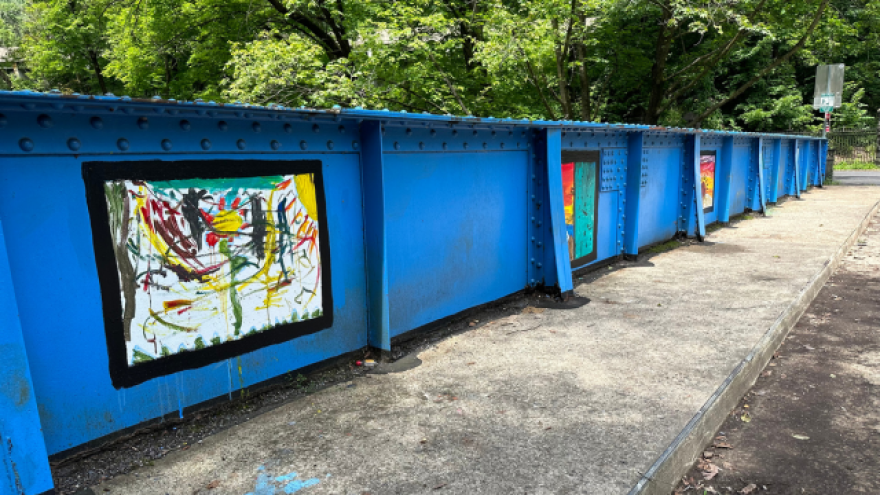EASTON, Pa. — When a dam is removed, the creek or stream it controlled will return to its natural state — flowing narrower and deeper, Kristie Fach said Thursday.
“That's what you see with every dam removal, and, as always, it depends on the height of the dam and how far back that goes,” said Fach, director of ecological restoration for Wildlands Conservancy.
“But during the design phase, and engineering, we look at all that.”
Weeks after a dam was removed from the Bushkill Creek as part of a years-long effort to improve its health, officials continue to restore its banks.
As part of the job, the Richard McAteer Memorial Bridge, also known by locals as the Blue Bridge, will be closed periodically over the next couple weeks for stabilization work.
“This is just a protective measure so that we don't have erosion issues.”Easton Public Works Director David Hopkins
“The work on the bridge is being done during the business day, and the bridge opens at night and on weekends,” Easton Public Works Director David Hopkins said. “This is just a protective measure so that we don't have erosion issues.”
The bridge, which provides access to the Karl Stirner Arts Trail, will be closed from 7:30 a.m. to 3:30 p.m. weekdays.
Dam removals on the Bushkill
In early June, Wildlands Conservancy, in collaboration with the Delaware River Basin Commission and Lafayette College, began to dismantle a dam on the Bushkill behind the city’s recycling center.
The dam, once among several on the creek used for water-powered mills, had fallen into disuse and disrepair, causing environmental and stormwater issues.
It was the third dam in the past year to be removed on the Bushkill, which begins at the foot of Blue Mountain in Bushkill Township and flows 16 miles south to its confluence with the Delaware River.
The first dam was demolished in July at the creek entrance behind Don Juan Mexican Grill, 300 N. Third St., on land owned by the college.
A second dam, owned by Simon Silk Mill, was removed that summer.
The cost to remove all three was more than $1 million, through partners and conservation grants.
With the dams removed, it’s the first time in more than a century fish and eels, as well as hitchhiking freshwater mussels, will be able to make their way from the Atlantic Ocean to the Delaware River and finally up the Bushkill Creek.
In all, five dams have been removed from the creek in the past half-decade. But they aren’t finished quite yet.
Conservancy officials plan to remove a fourth dam and install instream habitat at its Binney & Smith Preserve.
‘Armoring’ the bridge
When the most recent dam was removed, the water level upstream dropped.
“When that happens, sometimes, there can be scouring issues, where the water rubs in areas that it never did before,” Hopkins said.
“And sometimes there's unprotected parts of the bridge abutments that need to be — we call it armoring — but they need to have a protective element put in.”
Work includes adding a concrete covering on the roadside abutment, and a mix of large and small stone on the park side.
Lancaster County-based Flyway Excavating, a Wildlands contractor, is completing the work.
The work was planned as part of the dam removal process, and not unlike what was completed with a previous removal, which included a series of stabilization projects at bridges that cross the creek.
“The bridge was a little bit different because there wasn't a lot of information on how the bridge was built," Fach said. "We wanted to take another look at it when the water level is lower.
“So that's where we're at now, where we're fitting design plans to make sure that we're not creating additional scour, erosion at the bridge abutments.”
The iron bridge, originally from Brooklyn, was placed in 1918, according to the Karl Stirner Arts Trail website.
It was rededicated in October 2022 and named for Richard McAteer, a “community advocate and leader credited with the idea of featuring art in the planned recreational trail along the Bushkill Creek.”
“The dam removal is almost the easiest part. It's being responsible, making sure that there is no impact to infrastructure upstream, and that's what we're doing.”Kristie Fach, director of ecological restoration for Wildlands Conservancy
Construction is expected to start next week and continue for a couple weeks, she said.
“The dam removal is almost the easiest part,” Fach said. “It's being responsible, making sure that there is no impact to infrastructure upstream, and that's what we're doing.”


